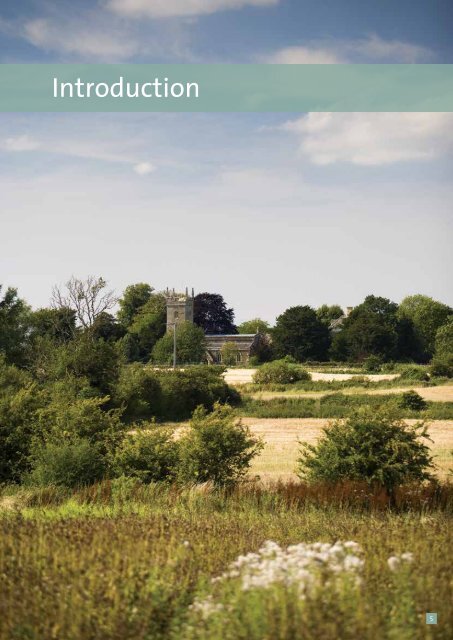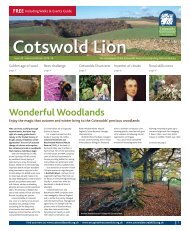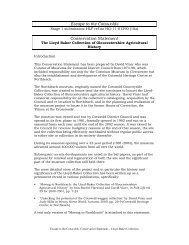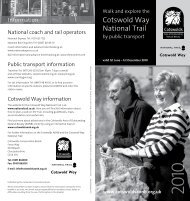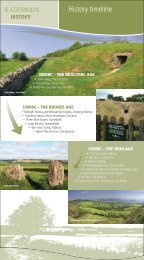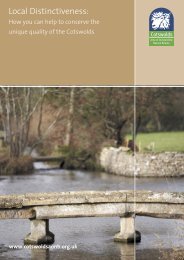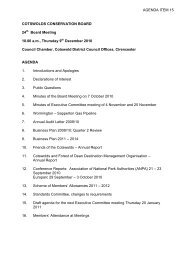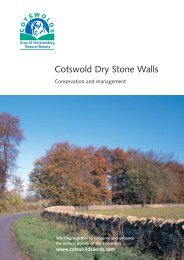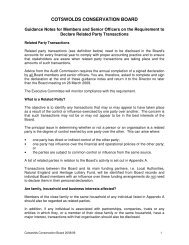Introduction - Cotswolds Area of Outstanding Natural Beauty
Introduction - Cotswolds Area of Outstanding Natural Beauty
Introduction - Cotswolds Area of Outstanding Natural Beauty
You also want an ePaper? Increase the reach of your titles
YUMPU automatically turns print PDFs into web optimized ePapers that Google loves.
<strong>Introduction</strong><br />
5
<strong>Cotswolds</strong> AONB Management Plan 2013-2018<br />
<strong>Introduction</strong><br />
The <strong>Cotswolds</strong> <strong>Area</strong> <strong>of</strong> <strong>Outstanding</strong> <strong>Natural</strong> <strong>Beauty</strong> (AONB) Management Plan 2013-18<br />
has three closely interrelated functions.<br />
Firstly, it is the statutory plan which sets out the<br />
<strong>Cotswolds</strong> Conservation Board’s (“the Board”) policies<br />
for the management <strong>of</strong> the <strong>Cotswolds</strong> AONB and for the<br />
carrying out <strong>of</strong> its functions in relation to it. 1 The actions<br />
the Board itself will take to deliver the Plan’s objectives<br />
are set out in the Board’s three-year rolling business<br />
plan.<br />
Secondly, it informs public bodies <strong>of</strong> the means by which<br />
they can demonstrate compliance with their statutory<br />
duty to “have regard to” the purpose <strong>of</strong> designation <strong>of</strong><br />
the AONB when undertaking their functions. 2<br />
Thirdly, it guides the engagement <strong>of</strong> public bodies,<br />
landowners, businesses and individuals in the<br />
management <strong>of</strong> the AONB. It includes information<br />
regarding available and potential delivery mechanisms.<br />
The types <strong>of</strong> actions the Board would encourage others<br />
to take individually or in partnership with others,<br />
including the Board, to deliver the Plan, are set out<br />
in the Engagement section (see p67).<br />
This statutory plan has significant weight in influencing<br />
the wide range <strong>of</strong> future decisions that will affect the<br />
AONB. It will operate alongside other statutory plans and<br />
programmes and a wide range <strong>of</strong> other national and<br />
local initiatives. The Board will seek formal recognition <strong>of</strong><br />
the Plan as a “material consideration” in adopted Core<br />
Strategies/Local Plans and Neighbourhood Planning<br />
documents.<br />
Golden Thread<br />
CCB Business<br />
Plan<br />
(what the CCB<br />
will do)<br />
Legislation<br />
National<br />
Policy and<br />
Guidance<br />
Vision<br />
Objectives<br />
(what we want to<br />
be achieved)<br />
Policies<br />
(agreed principles<br />
to guide decisions<br />
and actions)<br />
Delivery<br />
mechanisms<br />
Management Plan elements<br />
The Management Plan is structured along a simple<br />
‘Golden Thread’ that builds on the Vision and is based<br />
on its statutory purpose and arrived at by consultation.<br />
Engagement<br />
(What needs to be<br />
done by others)<br />
1. Section 89, Countryside and Rights <strong>of</strong> Way Act 2000 as amended<br />
by the NERC Act 2006<br />
2. Section 85, Countryside and Rights <strong>of</strong> Way Act 2000<br />
Implementation <strong>of</strong> the plan will be monitored and<br />
evaluated by the Board. An assessment <strong>of</strong> achievements<br />
will be provided as part <strong>of</strong> the Board’s annual report.<br />
6
<strong>Introduction</strong> Appendix<br />
Protected Landscapes: Appendix AONBs<br />
Protected Landscapes: AONBs<br />
AONBs and National Parks were brought into being by the same legislation in 1949 and<br />
have the same status and level <strong>of</strong> protection. AONBs are particularly special landscapes<br />
whose distinctive character and natural beauty are so outstanding that it is in the nation’s<br />
interest to safeguard them.<br />
The statutory purpose <strong>of</strong> AONB designation is to<br />
conserve and enhance natural beauty. 3<br />
The Countryside and Rights <strong>of</strong> Way (CROW) Act 2000<br />
confirmed the significance <strong>of</strong> AONBs. Section 85 places a<br />
statutory (legal) duty on all relevant authorities to have<br />
regard to the purpose <strong>of</strong> conserving and enhancing<br />
natural beauty when discharging any function in relation<br />
to, or affecting land within, an <strong>Area</strong> <strong>of</strong> <strong>Outstanding</strong><br />
<strong>Natural</strong> <strong>Beauty</strong>.<br />
The International Union for Conservation <strong>of</strong> Nature<br />
(IUCN) designates the UK’s AONBs as Category V –<br />
Protected Landscape/Seascape – ‘a protected area where<br />
the interaction <strong>of</strong> people and nature over time has<br />
produced an area <strong>of</strong> distinct character with significant<br />
ecological, biological, cultural and scenic value’.<br />
More information on AONBs and their status and<br />
protection can be found on the websites <strong>of</strong> the following<br />
organisations:<br />
• <strong>Cotswolds</strong> Conservation Board<br />
(www.cotswoldsaonb.org.uk),<br />
• Defra (www.defra.gov.uk),<br />
• <strong>Natural</strong> England (www.naturalengland.org.uk),<br />
and the<br />
• National Association for AONBs<br />
(www.landscapesforlife.org.uk).<br />
The <strong>Cotswolds</strong> Conservation Board<br />
The <strong>Cotswolds</strong> Conservation Board was established by<br />
Parliament in 2004 and has two statutory purposes: 4<br />
a) to conserve and enhance the natural beauty <strong>of</strong> the<br />
AONB; and<br />
b) to increase the understanding and enjoyment <strong>of</strong> the<br />
special qualities <strong>of</strong> the AONB.<br />
In fulfilling these roles, the Board has a duty to seek to<br />
foster the economic and social well-being <strong>of</strong> people<br />
living in the AONB.<br />
Section 89 <strong>of</strong> the Countryside and Rights <strong>of</strong> Way Act<br />
2000 places a statutory duty on the Conservation Board<br />
to produce a five-year management plan for the AONB.<br />
This is the third such document, and is structured around<br />
the Board’s purposes.<br />
3. Section 82, Countryside and Rights <strong>of</strong> Way Act 2000<br />
4. Section 87, Countryside and Rights <strong>of</strong> Way Act 2000 as amended by<br />
the NERC Act 2006<br />
7
<strong>Cotswolds</strong> AONB Management Plan 2013-2018<br />
Special Qualities <strong>of</strong> the <strong>Cotswolds</strong><br />
(Statement Of Significance)<br />
The area is a rich mosaic <strong>of</strong> historical, social, economic, cultural, geological,<br />
geomorphological 5 and ecological features. The special qualities <strong>of</strong> the <strong>Cotswolds</strong> include:<br />
• the unifying character <strong>of</strong> the limestone geology –<br />
its visible presence as natural outcrops, its use as a<br />
building material and through the plant and animal<br />
communities it supports;<br />
• the Cotswold escarpment, including views to and<br />
from it;<br />
• the high wolds – a large open, elevated landscape<br />
with commons, ‘big’ skies and long-distance views;<br />
• river valleys, the majority forming the headwaters<br />
<strong>of</strong> the Thames, with high-quality water;<br />
• dry stone walls, which give the AONB its essential<br />
character in many areas;<br />
• internationally important flower-rich limestone<br />
grasslands;<br />
• internationally important ancient broadleaved<br />
woodland, particularly along the crest <strong>of</strong> the<br />
escarpment;<br />
• variations in the colour <strong>of</strong> the stone from one part<br />
<strong>of</strong> the AONB to another which add a vital element <strong>of</strong><br />
local distinctiveness;<br />
• the tranquillity 6 <strong>of</strong> the area;<br />
• well-managed arable and livestock farms;<br />
• distinctive settlements, developed in the Cotswold<br />
vernacular, high architectural quality and integrity;<br />
• accessible landscape for quiet recreation; and<br />
• historic associations.<br />
5. Geomorphology is the physical features <strong>of</strong> an area, strongly<br />
influenced by geology.<br />
6. Tranquillity is very difficult to define but is essentially the absence<br />
<strong>of</strong> inappropriate noise, development, visual clutter and pollution,<br />
“a feeling <strong>of</strong> being away from it all”.<br />
8
<strong>Introduction</strong><br />
Special Qualities <strong>of</strong> the <strong>Cotswolds</strong><br />
Benefits <strong>of</strong> Managing the<strong>Cotswolds</strong> AONB<br />
Benefits <strong>of</strong> Managing the <strong>Cotswolds</strong> AONB<br />
The <strong>Cotswolds</strong> AONB delivers multiple benefits for society:<br />
• scenic beauty – an understanding and appreciation<br />
<strong>of</strong> the aesthetic benefits <strong>of</strong> landscape conservation;<br />
• cultural heritage – an understanding and appreciation<br />
<strong>of</strong> heritage;<br />
• green infrastructure 7 – providing connected,<br />
multifunctional and well-promoted green spaces<br />
and networks; and<br />
Many <strong>of</strong> the objectives set out in this Plan influence the<br />
management <strong>of</strong> land and natural systems in the AONB<br />
to help sustain and improve the range and quality <strong>of</strong><br />
public benefits and ecosystem services that are provided.<br />
The table below categorises the range <strong>of</strong> ecosystem<br />
services, the contribution made by ecosystems in the<br />
<strong>Cotswolds</strong> and the links to the objectives <strong>of</strong> the<br />
Management Plan (see pages 13-16).<br />
• sustainable economic growth through appropriate<br />
development, rural businesses and tourism 8 .<br />
• ecosystem services (see page 10).<br />
Ecosystem services<br />
The benefits people get from nature are <strong>of</strong>ten described<br />
as ‘ecosystem services’. Ecosystem services may be<br />
categorised as:<br />
• Provisioning services provided by natural resources<br />
such as food, water, fibre, and fuel;<br />
• Regulating services provided by natural systems<br />
including clean water and air, fertile soils, and climate<br />
regulation;<br />
• Cultural services including recreation, cultural<br />
heritage, spiritual and aesthetic values, inspiration<br />
and education;<br />
• Supporting services providing the basic infrastructure<br />
<strong>of</strong> life including soil formation, the cycling <strong>of</strong> water<br />
and nutrients, fixation <strong>of</strong> carbon by plants and the<br />
ecosystems themselves. All other ecosystem services<br />
ultimately depend on these supporting services.<br />
7. The Green infrastructure network includes open spaces, parks and<br />
gardens, allotments, woodlands, street trees, green ro<strong>of</strong>s, fields,<br />
hedges, lakes, ponds, playing fields, as well as footpaths, cycleways<br />
and waterways.<br />
8. The Gross Value Added to the economy <strong>of</strong> the <strong>Cotswolds</strong> AONB is<br />
estimated to be £337m/annum. “An assessment <strong>of</strong> the economic<br />
value <strong>of</strong> the <strong>Cotswolds</strong> AONB” Cumulus Consultants for CCB (2013).<br />
9
<strong>Cotswolds</strong> AONB Management Plan 2013-2018<br />
Ecosystem Services<br />
Provisioning Services<br />
Food (e.g. crops, livestock, fish, game) Cotswold farmers produce food through arable crops, the<br />
breeding <strong>of</strong> store lambs, suckled calves and, increasingly, finished lamb and beef and a limited<br />
quantity <strong>of</strong> dairy products.<br />
Link to Plan<br />
Objective/s<br />
CEO2<br />
Water supply The catchments on the <strong>Cotswolds</strong> provide drinking water for much <strong>of</strong> the population<br />
<strong>of</strong> south-east England.<br />
CEO3<br />
Fibre (e.g. timber, arable crops, wool) Historically, the <strong>Cotswolds</strong> has been an important producer<br />
<strong>of</strong> wool and timber, and there are opportunities to develop local markets and innovative uses.<br />
CEO2<br />
Fuel (e.g. renewable energy) The <strong>Cotswolds</strong> provides good conditions for renewable energy<br />
including hydro, solar and biomass and there is considerable scope for further development<br />
<strong>of</strong> this resource, particularly woodfuel.<br />
CEO3<br />
Genetic diversity The “Cotswold Lion” local breed <strong>of</strong> sheep helps retain important genetic diversity<br />
as well as contributing to local distinctiveness.<br />
Regulating Services<br />
Water purification and waste treatment Ecosystems can help in the filtering out and<br />
decomposition <strong>of</strong> organic wastes introduced into water bodies and can also assimilate and detoxify<br />
compounds through soil and sub-soil processes. The <strong>Cotswolds</strong> generally has good water quality,<br />
although some rivers and ground-waters do not meet current standards <strong>of</strong> ‘good ecological status’.<br />
CEO2<br />
CEO3<br />
Link to Plan<br />
Objective/s<br />
CEO3<br />
Water flow and flood risk Healthy porous soils and vegetation, particularly woodlands, help to<br />
regulate water flow and alleviate flooding in times <strong>of</strong> high and low rainfall. Action in the <strong>Cotswolds</strong><br />
to manage catchments can help reduce peak flood levels and sustain river flows during drought<br />
periods.<br />
CEO3<br />
Disease and pest regulation Diseases and pests are regulated by natural factors such as predators<br />
and climate, although additional interventions may be required. A healthy and diverse ecosystem<br />
is less vulnerable to pests and disease.<br />
CEO5<br />
Pollination Pollination <strong>of</strong> crops is important for food supply. Most wildflowers are also dependent<br />
on insect pollination, yet the numbers <strong>of</strong> wild and managed pollinators, such as bees, are in decline.<br />
CEO3<br />
Climate regulation and carbon storage Plants influence climate both locally and globally. Carbon<br />
is absorbed from the atmosphere in farmland and woodlands and an important carbon store is<br />
provided in the soils.<br />
CEO2<br />
CEO3<br />
CEO5<br />
10
<strong>Introduction</strong><br />
Ecosystem Services<br />
Ecosystem Services<br />
Cultural Services<br />
Cultural heritage and historic environment Human influence in the <strong>Cotswolds</strong> can be traced<br />
back more than 5,000 years and includes 436 scheduled ancient monuments and more than<br />
9,000 listed buildings.<br />
Spiritual and religious values The Cotswold landscape and relative tranquillity provide spiritual<br />
inspiration and enrichment from nature for many people.<br />
Aesthetic values The <strong>Cotswolds</strong> is renowned internationally for the beauty <strong>of</strong> its landscapes that<br />
have inspired arts and culture.<br />
Inspiration The <strong>Cotswolds</strong> has strong traditions <strong>of</strong> literature, art, folklore and oral history<br />
inextricably linked to the <strong>Cotswolds</strong> landscape.<br />
Education The <strong>Cotswolds</strong> provides a location for both formal and informal education and the<br />
Cotswold Voluntary Wardens educational programme provides opportunities for pupils to learn<br />
about and experience the <strong>Cotswolds</strong> environment.<br />
Recreation and tourism More than 23 million visitor days are spent in the AONB each year,<br />
and tourism is worth around £1 billion to the local economy.<br />
Supporting Services<br />
Wildlife/biodiversity Increased recognition <strong>of</strong> the roles that organisms and their interactions play<br />
in driving ecosystem processes has led to efforts aimed at increasing biodiversity, in terms <strong>of</strong><br />
species richness and composition and restoring and connecting habitats. The <strong>Cotswolds</strong> contains<br />
important and rare habitats and species and their conservation is vital to sustaining the<br />
ecosystems that deliver the range <strong>of</strong> services set out above.<br />
Primary production The degree to which solar energy is assimilated and biomass accumulated is<br />
dependent, in part, on the biological composition <strong>of</strong> plant communities and their interactions.<br />
Soil production Soil formation is driven by the interaction between plants and micro-organisms<br />
and the underlying geology. Many ecosystem services depend on healthy soils but soils form<br />
slowly and can be quickly degraded and lost due to inappropriate land management, erosion,<br />
climate warming, and inundation <strong>of</strong> coastal soils due to sea-level rise.<br />
Nutrient cycling Plants, animals and micro-organisms play a crucial role in the cycling <strong>of</strong> nutrients<br />
essential for the delivery <strong>of</strong> ecosystem benefits. Disturbance <strong>of</strong> natural processes can lead to<br />
enrichment <strong>of</strong> terrestrial and aquatic habitats by, for example, increased inputs <strong>of</strong> nitrogen and<br />
phosphorus from sewage and fertiliser run<strong>of</strong>f, leading to poor water quality and, in some cases,<br />
undesirable algal blooms.<br />
Link to Plan<br />
Objective/s<br />
CEO4<br />
UEO1<br />
UEO1<br />
UEO1<br />
UEO2<br />
UEO2, UEO3<br />
UEO5<br />
Link to Plan<br />
Objective/s<br />
CEO5<br />
CEO2<br />
CEO5<br />
CEO2<br />
CEO5<br />
CEO2<br />
CEO5<br />
11
<strong>Cotswolds</strong> AONB Management Plan 2013-2018<br />
Plan Structure and Consultation<br />
The Vision is taken forward through a series <strong>of</strong> objectives informed by relevant legislation,<br />
national policies and guidance which are linked to the Board’s statutory purposes and duty.<br />
These are followed by a series <strong>of</strong> Themes. Each thematic<br />
section contains a short description <strong>of</strong> its different<br />
aspects, followed by:<br />
• special qualities <strong>of</strong> the AONB associated with that<br />
theme;<br />
• key issues with respect to each theme; and<br />
• relevant Plan objective/s.<br />
These are all used to develop:<br />
• policies to guide activity<br />
• indicative delivery mechanisms and<br />
• monitoring indicators to demonstrate achievement<br />
<strong>of</strong> the objectives.<br />
All these in turn lead to the actions encouraged in the<br />
Engagement section (see page 68). Actions the Board<br />
intends to take are set out in detail in the Board’s threeyear<br />
rolling business plan. 9<br />
Consultation<br />
This Plan has been produced with a full and<br />
comprehensive documented programme <strong>of</strong> public<br />
involvement and consultation. It is also supported by a<br />
Strategic Environmental Assessment (SEA), a Habitats<br />
Regulation Assessment as required by the European<br />
Habitats Directive and an Equalities Assessment. 10<br />
9. www.cotswoldsaonb.org.uk/board<br />
10. All documents are available on the Board’s website<br />
www.cotswoldsaonb.org.uk<br />
COTSWOLDS CONSERVATION BOARD<br />
POSITION STATEMENT<br />
Development in the setting <strong>of</strong><br />
the <strong>Cotswolds</strong> AONB<br />
<strong>Introduction</strong><br />
1. <strong>Area</strong>s <strong>of</strong> <strong>Outstanding</strong> <strong>Natural</strong> <strong>Beauty</strong> (AONBs) are designated by the Government<br />
for the purpose <strong>of</strong> ensuring that the special qualities <strong>of</strong> the finest landscapes in England<br />
and Wales are conserved and enhanced. In policy terms they have the same planning<br />
status as National Parks.<br />
2. The <strong>Cotswolds</strong> Conservation Board is the body set up by Parliament to conserve<br />
and enhance the natural beauty <strong>of</strong> the <strong>Cotswolds</strong> AONB and increase the awareness and<br />
understanding <strong>of</strong> the special qualities <strong>of</strong> the AONB. The Board also has a duty to have<br />
regard to the social and economic needs <strong>of</strong> those who live and work in the <strong>Cotswolds</strong>.<br />
Purpose<br />
3 This Statement provides guidance to and local planning authorities, landowners and<br />
other interested parties regarding the consideration <strong>of</strong> the impact <strong>of</strong> development and land<br />
management 1 proposals which lie outside the AONB but within its “setting”.<br />
4. The Board considers the setting <strong>of</strong> the <strong>Cotswolds</strong> AONB to be the area within<br />
which development and land management proposals, by virtue <strong>of</strong> their nature, size,<br />
scale, siting materials or design can be considered to have an impact, positive or<br />
negative, on the natural beauty and special qualities <strong>of</strong> the <strong>Cotswolds</strong> AONB.<br />
5. This Statement expands upon issues raised in the <strong>Cotswolds</strong> AONB Management<br />
Plan 2008-13 2 , in particular key issue LK3 and policy LP1.<br />
LK3: The surroundings <strong>of</strong> the AONB are also important to its landscape character and<br />
quality. Views out <strong>of</strong> the AONB and into its surrounding areas can be very significant.<br />
Development proposals that affect views into and out <strong>of</strong> the AONB need to be carefully<br />
assessed in line with Planning Policy Statement 7 to ensure that they conserve and<br />
enhance the natural beauty and landscape character <strong>of</strong> the AONB.<br />
1 “Development” includes transport and other infrastructure as well as proposals<br />
requiring planning applications. “Land management” includes tree planting, energy<br />
crops, and drainage schemes.<br />
2 <strong>Cotswolds</strong> AONB Management Plan 2008-13, <strong>Cotswolds</strong> Conservation Board (2008)<br />
http://www.cotswoldsaonb.com/page.asp?pageID=12<br />
Position Statements<br />
The Board has issued a number <strong>of</strong> Position Statements<br />
which amplify some policies in the Plan. These are<br />
usually subject to consultation with local authorities<br />
and relevant organisations and individuals. They contain<br />
further background information and are reviewed and<br />
updated on a regular basis to ensure compliance with<br />
national policy.<br />
All Position statements can be viewed on the Board’s<br />
website at www.cotswoldsaonb.org.uk/<br />
positionstatements<br />
1<br />
12
<strong>Introduction</strong><br />
Plan Structure and Consultation<br />
Conserving and Enhancing – Objectives<br />
Conserving and Enhancing – Objectives<br />
<strong>Introduction</strong><br />
The purpose <strong>of</strong> the designation <strong>of</strong> the <strong>Cotswolds</strong> AONB and the primary purpose <strong>of</strong> the<br />
<strong>Cotswolds</strong> Conservation Board is to conserve and enhance the natural beauty <strong>of</strong> the AONB.<br />
The objectives and thematic policies in this section<br />
contribute to the achievement <strong>of</strong> this purpose.<br />
Conserving and enhancing the characteristic <strong>Cotswolds</strong><br />
environment provides a wide range <strong>of</strong> benefits that are<br />
beyond monetary value and become <strong>of</strong> ever greater<br />
importance as the surrounding urban population grows<br />
and the impacts <strong>of</strong> change in the wider world accelerate.<br />
These benefits include:<br />
• an internationally important, large-scale managed<br />
landscape;<br />
• high-quality food and wood products produced close<br />
to local markets;<br />
• biodiversity, geological and cultural resources, many <strong>of</strong><br />
national and/or international importance, which are<br />
fragile, irreplaceable within a lifetime and, in the<br />
case <strong>of</strong> geological and archaeological sites and the<br />
extensive historic built environment, finite;<br />
• helping to meet the water needs <strong>of</strong> southern England<br />
and providing local flood risk management;<br />
• capturing and storing CO 2 from the atmosphere<br />
(carbon sequestration) through its woods and<br />
vegetation cover; and<br />
• a tranquil resource, which contributes to the health<br />
and well-being <strong>of</strong> the wider population, with distinct<br />
restorative benefits, sense <strong>of</strong> place, opportunities for<br />
relaxation and escape in natural surroundings.<br />
Objectives<br />
CEO1: By 2018 it can be demonstrated that organisations and individuals responsible for land management and<br />
development management have conserved and enhanced the special qualities <strong>of</strong> the Cotswold landscape.<br />
CEO2: By 2018 sustainable farming and forestry remain the primary means by which the distinctive landscapes<br />
<strong>of</strong> the <strong>Cotswolds</strong> are managed.<br />
CEO3: By 2016 national and local agencies have put in place policies and guidance to implement the sustainable<br />
provision and use <strong>of</strong> natural resources in the <strong>Cotswolds</strong> AONB.<br />
CEO4: By 2018 relevant organisations have demonstrably better identified, recorded and promoted, the distinctive<br />
historic and cultural and natural heritage <strong>of</strong> the <strong>Cotswolds</strong> AONB, which is better understood by residents and visitors.<br />
CEO5: By 2014 relevant organisations have strengthened landscape-scale restoration and the re-linking and<br />
management <strong>of</strong> habitats to reverse ecological fragmentation and to improve the resilience <strong>of</strong> the Cotswold landscape,<br />
habitats and water environment to the effects <strong>of</strong> climate change.<br />
CEO6: By 2014 national and local development management and transport authorities and agencies have policies<br />
and guidance to make decisions which conserve and enhance the special qualities <strong>of</strong> the AONB, maintain local<br />
distinctiveness, provide services and support a buoyant rural economy.<br />
13
<strong>Cotswolds</strong> AONB Management Plan 2013-2018<br />
Understanding and Enjoying – Objectives<br />
<strong>Introduction</strong><br />
The Conservation Board’s second purpose is “increasing the understanding and<br />
enjoyment by the public <strong>of</strong> the special qualities <strong>of</strong> the area <strong>of</strong> outstanding natural beauty”. 11<br />
The objectives and policies in this section (see p51) contribute to the achievement <strong>of</strong><br />
this purpose.<br />
This purpose has taken on increasing relevance over<br />
the last few years as more people seek to explore and<br />
enjoy the Cotswold landscape. The Government’s<br />
commitment, through its <strong>Natural</strong> Environment White<br />
Paper, to have “by 2020 significantly more people<br />
engaged in biodiversity issues, aware <strong>of</strong> its value and<br />
taking positive action” 12 , is an example <strong>of</strong> one aspect<br />
<strong>of</strong> delivering this purpose which helps to make the<br />
connection with conserving and enhancing the AONB.<br />
Objectives<br />
The Cotswold countryside has long been valued for its<br />
wealth <strong>of</strong> opportunities for outdoor recreation and quiet<br />
enjoyment. These opportunities provide the means to<br />
explore and discover the richness <strong>of</strong> the natural beauty<br />
and historic interest <strong>of</strong> the AONB while at the same time<br />
contributing to physical and mental health and wellbeing.<br />
The publicly accessible open spaces include public<br />
footpaths and bridleways, commons, woodlands, parks<br />
and gardens, canals and waterways, and green spaces<br />
associated with settlements, such as village greens.<br />
Together these form the extensive “green infrastructure”<br />
<strong>of</strong> the <strong>Cotswolds</strong> which provide significant economic,<br />
social and health benefits. 13<br />
UEO1: By 2018 it can be shown that residents and visitors demonstrably value the natural beauty, historic character<br />
and cultural heritage <strong>of</strong> the <strong>Cotswolds</strong> and understand the need to invest in and sensitively manage the special<br />
qualities <strong>of</strong> the area.<br />
UEO2: By 2018 relevant organisations make the <strong>Cotswolds</strong> a landscape available for all to explore and enjoy,<br />
which is demonstrably regarded by residents and visitors as a place for positive, high-quality experiences.<br />
UEO3: By 2018 providers <strong>of</strong> opportunities to improve health, through recreation and better housing conditions in the<br />
<strong>Cotswolds</strong> AONB, can show successful outcomes.<br />
UEO4: By 2016 public support, commitment and participation in conserving and enhancing the AONB by volunteering<br />
and involvement with relevant organisations has increased significantly.<br />
UEO5: By 2016 the <strong>Cotswolds</strong> is widely recognised and valued as a sustainable visitor destination, where local<br />
communities benefit, businesses prosper and the environment is sustained through the co-ordinated delivery <strong>of</strong><br />
quality and enriching visitor experiences.<br />
11. Section 87, Countryside and Rights <strong>of</strong> Way Act 2000<br />
12. “<strong>Natural</strong> Choice – securing the value <strong>of</strong> nature” Defra (2011)<br />
14<br />
13. “Benefits <strong>of</strong> green infrastructure.” Report to Defra and CLG.<br />
Forest Research, (2010)
<strong>Introduction</strong><br />
Understanding and Enjoying – Objectives<br />
Fostering Economic and Social Well-Being – Objectives<br />
Fostering Economic and Social Well-Being –<br />
Objectives<br />
In delivering its two purposes the Board has a statutory duty to seek to foster the<br />
economic and social well-being <strong>of</strong> people living in the AONB.<br />
Addressing this duty informs the overall strategic<br />
approach to the management <strong>of</strong> the <strong>Cotswolds</strong> AONB.<br />
This section <strong>of</strong> the Plan identifies the key social and<br />
economic management issues relevant to the AONB<br />
as a whole. It examines the likely impacts on the AONB<br />
from a variety <strong>of</strong> forces and identifies objectives for the<br />
management <strong>of</strong> these. The Board seeks to deliver its duty<br />
through the achievement <strong>of</strong> its two purposes rather than<br />
as a separate strand <strong>of</strong> activity.<br />
Securing the resilience <strong>of</strong> the Cotswold economy<br />
and the quality <strong>of</strong> life in the light <strong>of</strong> demographic<br />
changes and economic conditions.<br />
Key Issues<br />
The UK population is projected to exceed 70 million by<br />
2027. 14 Much <strong>of</strong> the increase in population in rural areas<br />
is the result <strong>of</strong> migration for lifestyle reasons, including<br />
retirement. The scale <strong>of</strong> development required to provide<br />
housing, employment and services to this expanding and<br />
ageing population will be considerable and the pressure<br />
to develop land and introduce other urban land uses<br />
within and around the AONB will become significant.<br />
The AONB is surrounded by the towns and cities <strong>of</strong><br />
Banbury, Bath, Cheltenham, Chippenham, Cirencester,<br />
Evesham, Gloucester, Keynsham, Oxford, Stroud,<br />
Swindon, and Yate all <strong>of</strong> which are expected to<br />
accommodate significant housing and employment<br />
development in the next 20 years.<br />
The increasing demand for more reliable journey times<br />
between employment centres will lead to pressure for<br />
road widening and other ‘improvement’ schemes on<br />
major roads in the AONB. This could be mitigated if<br />
increasing fuel prices produce changing working<br />
14. Office for National Statistics, (2012).<br />
patterns with more working from home and less lengthy<br />
daily commuting; this would be assisted by the provision<br />
<strong>of</strong> high speed broadband and improvements to rail<br />
networks through electrification and increased capacity.<br />
Unless effectively managed, all <strong>of</strong> these pressures will<br />
work cumulatively to impact adversely on the landscape<br />
character, tranquillity and economy <strong>of</strong> the area. The<br />
Board’s role is to ensure that the conservation and<br />
enhancement <strong>of</strong> the landscape is incorporated into<br />
strategies, plans and decisions <strong>of</strong> other agencies and<br />
bodies which address these issues in a coherent and<br />
consistent way, and to encourage relevant activity. Public<br />
bodies have a duty under Section 85 <strong>of</strong> the Countryside<br />
and Rights <strong>of</strong> Way Act to “have regard to” the purpose <strong>of</strong><br />
designation <strong>of</strong> the <strong>Cotswolds</strong> AONB when undertaking<br />
their functions. 15<br />
The successful development <strong>of</strong> the rural economy has an<br />
important role to play in securing resources to manage<br />
the AONB. The high-quality environment is a strong<br />
factor in attracting inward investment and tourism to<br />
create employment opportunities both locally and in<br />
surrounding towns and cities. The AONB is an attractive<br />
location for entrepreneurs and for associated workforces,<br />
with 14% <strong>of</strong> employment critically dependant on the<br />
high quality environment and landscape <strong>of</strong> the AONB. 16<br />
In the same study 74% <strong>of</strong> businesses surveyed suggested<br />
that a deterioration in the quality <strong>of</strong> the landscape<br />
15. Guidance on how pubic bodies can comply with this duty is set out<br />
in “Duties on relevant authorities to have regard to the purposes <strong>of</strong><br />
National Parks, <strong>Area</strong>s <strong>of</strong> <strong>Outstanding</strong> <strong>Natural</strong> <strong>Beauty</strong> (AONBs) and<br />
the Norfolk and Suffolk Broads” Defra (2005), http://archive.defra.<br />
gov.uk/rural/documents/protected/npaonb-duties-guide.pdf and<br />
“England’s statutory landscape designations: a practical guide to<br />
your duty <strong>of</strong> regard” <strong>Natural</strong> England NE 243 (2010)<br />
16. ‘Assessment <strong>of</strong> the Economic Value <strong>of</strong> the <strong>Cotswolds</strong> AONB’<br />
Cumulus Consulting for CCB (2013)<br />
15
<strong>Cotswolds</strong> AONB Management Plan 2013-2018<br />
would affect business performance, with 25% reporting<br />
it would have a ‘serious’ effect on their business.<br />
The appropriate management <strong>of</strong> the AONB also provides<br />
opportunities for people to enjoy healthy active lifestyles<br />
through access, participation and enjoyment <strong>of</strong> space<br />
and tranquillity. 17<br />
• provide examples <strong>of</strong> landscape-scale biodiversity<br />
initiatives;<br />
• provide green infrastructure, water and food;<br />
• contribute towards addressing climate change issues;<br />
and<br />
• provide havens <strong>of</strong> tranquillity <strong>of</strong> value to residents and<br />
surrounding urban populations.<br />
Providers <strong>of</strong> such activities acknowledge the importance<br />
<strong>of</strong> the quality <strong>of</strong> the landscape in attracting visitors.<br />
Over 120 providers <strong>of</strong> holidays in the <strong>Cotswolds</strong> AONB<br />
are currently listed on the ‘Our Land’ website. 18<br />
Demonstrating the relevance <strong>of</strong> protected landscape<br />
management in the wider environmental, social<br />
and economic context<br />
The context in which designated landscapes sit now<br />
differs considerably from what it was when the concept<br />
was enshrined in statute in 1949. 19 At that time the main<br />
threats to natural beauty were suburbanisation, lack <strong>of</strong><br />
high-quality public access, and quarrying. Whilst these<br />
issues still remain <strong>of</strong> concern, new challenges and<br />
opportunities present themselves to increase the<br />
relevance <strong>of</strong> the concept beyond the original purpose<br />
<strong>of</strong> designation.<br />
Designated landscapes are now additionally recognised<br />
as important resources to:<br />
• stimulate the rural economy;<br />
• contribute to people’s health and well-being;<br />
The ability <strong>of</strong> nationally designated landscapes,<br />
particularly AONBs and National Parks, to fully deliver<br />
these benefits to society is <strong>of</strong>ten constrained by the<br />
fragmented administrative arrangements in which they<br />
are situated. The AONB Management Plan is the<br />
mechanism by which:<br />
• these benefits can be brought to the attention <strong>of</strong><br />
national and local policy makers and decision takers;<br />
• a consistent and comprehensive approach to the<br />
management <strong>of</strong> the AONB, in order to deliver these<br />
benefits, can be communicated to delivery<br />
organisations;<br />
• the AONB is managed as a whole – this is important<br />
because biodiversity, and local residents and visitors<br />
who see the landscape and attractions as “the<br />
<strong>Cotswolds</strong>”, do not recognise the administrative<br />
boundaries that fragment the area; and<br />
• a unified approach can be taken to the provision <strong>of</strong><br />
high-quality access to natural environments, providing<br />
greater understanding and social and economic<br />
benefits through tourism.<br />
Objectives<br />
ESO1: By 2015 the Board has understood the potential impacts <strong>of</strong> economic and demographic changes on the quality<br />
<strong>of</strong> life and the economy <strong>of</strong> the AONB, and by 2017 the Board has a response in place.<br />
ESO2: By 2018 national and local agencies recognise the value and relevance <strong>of</strong> the AONB as a valuable source <strong>of</strong><br />
“ecosystem services”, economic and health benefits.<br />
17. See Understanding and Enjoying section for more details<br />
18. www.our-land.co.uk<br />
19. National Parks and Access to the Countryside Act 1949<br />
Policies to guide decisions and actions to secure these<br />
objectives are identified in subsequent thematic sections<br />
<strong>of</strong> the Plan.<br />
16


